|
The modern era of
neurotologic transtemporal skull base surgery began in 1961 when William
House introduced the operating microscope and multidisciplinary surgery
for the removal of acoustic neuromas with low mortality rate and enhanced
facial nerve preservation rate. An array of neurotologic procedures
provide safe exposure of the mid brain,clivus, CPA, petrous apex and
infratemporal fossa.
The
objective of transtemporal surgery is obtaining wide skull base exposure
by precise dissection of the temporal bone. These
collaborative techniques by neurotologist and neurosurgeon provide wide
surgical exposure and minimize brain retraction. Knowing theanatomy of
the temporal bone is essential to understand about these approaches.
Anatomy of Temporal Bone:
The
temporal bone contains and is surrounded by many important
structures. It articulates with five other cranial bones: the
frontal, parietal, sphenoid, occipital and zygomatic.
It can be divided into four parts: the squamous,mastoid, petrous and
tympanic.
a) Squamous portion:
The
lateral surface defines the boundary of the middle cranial fossa.
It extends medially to join the superior surface of the petrous bone in
the region of the tegmen.
b) Mastoid portion:
Pneumatization
within the mastoid process is variable. The squama of the temporal
bone forms the lateral wall of the central air containing space, the
antrum, which communicates with middle ear by the aditus. The
suprameatal spine and cribrifom area provide important landmarks for
surgical access to the anturm. From here pneumatization may extend
inferiorly into the tip of the mastoid process. Pneumatization also
extends into the perilabyrinthine region and petrous portion of the
temporal bone.
c) Petrous portion:
The
petrous portion of thetemporal bone roughly assumes the configuration of
a four-sided pyramid. Within the body of the petrous bone is found
the labyrinth and internal carotid artery, CN VII and CN VIII, all
penetrate the bone substance. The medial wall of the middle ear
cavity contains the first turn of the cochlea.
d) Tympanic portion:
The
tympanic part of the temporal bone forms the anterior and inferior walls
and part of the posterior wall of the external auditory meatus.It is
separated anteriorly from the squamous bone by the tympanosquamous suture
more medially from the petrous bone by the petrotympanic fissure and
posteriorly from the mastoid portion of the petrous bone by the
tympanomastoid fissure. The inner part of the
tympanic ring is grooved and is called the tympanic sulcus,
which accomodates the tympanic membrane annulus. The inferior
aspect of the tympanic bone is elongated into a vaginal process
immediately anterior to the styloid process.
Superior and anterior surface:
This
forms part of the middle cranial fossa. The foramen lacerum is
found between the apex of the petrous bone and sphenoid bone and contains
but does not transmit the ICA. Near the apex is a small depression
which lodges the trigeminal ganglion. The arcuate eminence of the
petrous bone overlies the superior semi-circular canal. The tegmen
tympani is lateral to the eminence. The opening of the hiatus of
the facial canal is anterior and medial to the arcuate eminence; this
transmits the superficial petrosal branch of the middle meningeal artery
and the greater petrosal nerve.
Posterior cerebellar surface:
Posterior
surface of the petrous bone forms the anterolateral surface of the
posterior fossa. A sulcus for the superior petrosal sinus defines
its superior border.Posteriorly it articulates with the occipital bone.
Approximately midway between the apex and the anterior border of sigmoid
sulcus is the IAM. It is a short canal begins medially at the
internal acoustic pore.A bony plate which is also part of the medial wall
of the cochlea and vestibule closes the lateral end. A horizontal
ridge of bone, the transverse crest,divides thepore into upper and lower
areas. Theanterior portion of the superior division contains the
facial nerve which is separated from the superior vestibular nerve
in the posterior portion of the upper division by a small, vertical crest
of bone,known as ' Bill's bar'. It serves as an important landmark
during the translabyrinthine approach. The cochlear nerve
lies in the anterior portion and the inferior vestibular nerve in the
posterior
portion
of the lower division. Midway between the meatus and sigmoid
sulcus, is the vestibular aqueduct which transmits the endolymphatic sac
and duct.
Inferior surface:
Most
irregular of the petrous bone'ssurfaces. The opening of the carotid canal
is aboutmidway between the apex and base; this is the entrance for the
ICA and its plexus of veins and sympathetic nerves. The canal
courses in a cephalad direction along the anterior wall of the tympanic
cavity to the bony eustachian tube and then bends
horizontally,ending at the apex of the petrous bone and the occipital
bone. Carotid ridge is a sharp bone separating the carotid
and jugular foramen. The lateral part of the foramen contains the
sigmoid portion of the transverse sinus; the medial part contains the
inferior petrosal sinus and the glossophayrngeal ,vagus and accessory
nerve. Anterior to the lateral compartment is the broad fossa for
the jugular bulb. Posterior and lateral to it is the styloid
process. Lateral to its base is the stylomastoid foramen
transmitting
facial
nerve.
Facial nerve:
The
facial nerve lies in the anterosuperior part of IAM, anterior to
Bill's bar. It passes laterally over the labyrinth (Labyrinthine
segment) to reach the geniculate ganglion.There it makes as
acute bend, running posteriorly upto the lateral semicircular canal
(tympanic segment). There it takes 90 degree bend to run in
the inferior direction (mastoid segment) before it exits through the
stylomastoid foramen.
Surgical approaches:
Approaches that traverse the otic capsule (Transcapsular) permit wide
exposure but sacrifice hearing: translabyrinthine (TL), Trans otic (TO)
and Transcochlear (TC).
Posterior
approaches that spare the otic capsule (Retro capsular)
provide varying degrees of CPA exposure with an opportunity for hearing
preservation: retro labyrinthine (RL), retro sigmoid (RS).
Superior
approaches (Supra Capsular) permit unroofing of the internal
auditory canal (IAC) with varying degrees of petrous apex exposure and an
opportunity for hearing preservation: middle fossa (MF) and extended
middle fossa (EMF).
The inferior
approaches: infracochlear (IC) and infralabyrinthine (IL).Removal of the
otic capsule provides the most direct
route to the IAC and CPA without the need for brain retraction.
1) TRANSLABYRINTHINE APPROACH: click for intra-operative video clippings
The TL approach is applicable for CPA and IAC lesions of all sizes
especially in patients with poor hearing. Even though this approach
is popularized for acoustic neuromas, it is suited for any neoplasm
requiring exposure of the CPA. In patients without useful hearing,
the TL approach is also useful for facial nerve tumours and vestibular
neurectomy.
|
Technique:
Surgical Highlights
· Retro auricular incision
· Cortical Mastoidectomy
· Posterior labyrinthectomy
· Exposure of the
internal auditory canal
· Identification of the Facial nerve at the meatal foramen
|
|
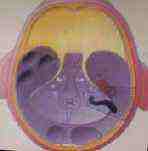
|
|
. Removal of lesion or nerve section
· Aditus, mastoid cavity and vestibule obliterated with musculo facial
graft and fat.
|
|
extent of bone
removal in translab.approach
|
|
The
patient is supine with the head turned to the opposite side.
A
curved post auricular incision is made with the apex 3 to 4 cm
posterior to the post auricular crease.
Complete
cortical mastoidectomy is performed.
The
tegmen and posterior fossa dural plate are identified and
the sigmoid sinus is skeletonized.
Exposure
of the retrosigmoid posterior fossa dura for at least 1 cm behind the
sigmoid sinus is important.
Anteriorly
the facial nerve is identified in its vertical segment but left covered
with bone
for
protection against inadvertent burr trauma.
|
|
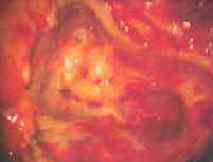
|
|
Next step is
labyrinthectomy by drilling out the semicircular canals. Care is
taken to leave the anterior wall of the lateral canal, and
the most anterior part of the ampulla of the
superior canal in
order to protect the tympanic and labyrinthine portions of the
facial
|
|
lateral, posterior
& superior semicircular canals seen after cortical mastoidectomy
|
|
nerve
and to serve as a landmark for the superior vestibular nerve.
All
IAC bone removal is completed before the dura is opened and
the IAC neural structures are exposed.
IAC
skeletonization begins by drilling a trough along the inferior edge of
the vestibule until the jugular bulb is identified - the inferior
limit of dissection.
The
anterior limit of dissection is the cochlear aqueduct. Once the
inferior border of the IAC is identified, a superior trough is drilled
along the superior edge of IAC. A full of 270 degree
skeletonization of the IAC dura is critical to prevent bony
edges from interfering with adequate tumor removal. Particular
attention is required along the lateral extent of
|
|
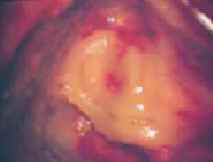
|
|
the
IAC to preserve crucial landmarks for facial nerve dissection
|
|
labyrinthectomy in progress
|
|
Tumor Removal:
In small lesions the tumor is exposed by opening the dura
of IAC. The superior vestibular nerve is transected by
placing an angled instrument adjacent to Bill's bar and reflecting the
superior vestibular nerve and it identifies the lateral plane
between the facial nerve and the tumor. Sharp and blunt
dissection can proceed without actually placing traction on the facial
nerve.
|
|
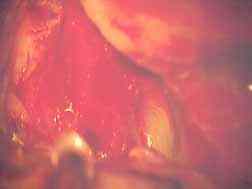
|
|
In large
tumors, CPA exposure is necessary. Intracapsular tumour debulking
is completed
before the tumor is
dissected directly from the facial nerve. After
tumor removal eustachian tube is packed with surgicel and
temporalis muscle.
|
|
bone surrounding the IAM removed for 270
degrees. Tumor in the IAM seen
|
|
The dural defect is loosely approximated with sutures and the
mastoidectomy defect is filled with strips of abdominal fat.
The TL approach provides wide and direct access to CPA
tumors with minimal cerebellar retraction.
It permits identification of the facial nerve - laterally
at the fundus and medially at the brain stem, which helps in anatomic
preservation of the facial nerve.
|
|
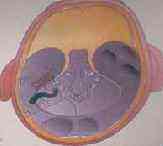
|
|
The disadvantage
of this approach is that hearing cannot be preserved.
|
|
extent of bone removal in transcochlear
approach
|
|
2) TRANSCOCHLEAR
APPROACHES: click for intra-operative video clippings
While
TL approach offers wide exposure of the CPA,the cochlea and petrous apex
block access to the anterior aspects of the CPA and the ventral brain
stem.
A spectrum of transcochlear approaches provide access to
the ventral brain stem, beginning with the transotic (TO) and extending
to a true transcochlear (TC), with the widest exposure being the
transpetrous (TP).
|
|

|
|
All these
approaches, by definition, remove the cochlea following a TL approach
to extend the exposure anteriorly.
The facial nerve remains in situ (although skeletonized)
in the TO approach,
|
|
subtotal
petrosectomy done. semiocircular canals being drilled out.;tympanic
& mastoid segment of facial nerve decompressed
|
|
The facial nerve
is transposed posteriorly in the TC approach.
The TP approach includes the full TC with the addition of
an infra temporal fossa approach and even transposition of the petrous
carotid artery in certain cases.
The disadvantage of this approach is that hearing cannot be preserved.
3) TRANSOTIC APPROACH:
|
|
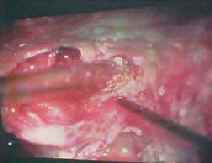
|
|
Surgical Highlights:
|
|
facial nerve exposed;exposure of
geniculate ganglion & GSPN
|
|
Retro
auricula-temporal incision
.Blind closure of external auditory canal
.Subtotal
petrosectomy
.Tympanic and mastoid fallopian canal left as a bridge
over the cavity
Otic capsule
removed to expose the complete medial surface of the temporal
bone.
Maximal trans temporal exposure of the internal auditory canal and
CP angle.
Direct anterior approach to the intrameatal and
intracranial facial nerve.
Dura reconstructed with musculo facial graf.
|
|
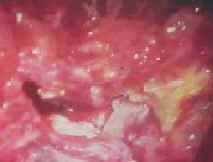
|
|
Cavity obliterated
with fat and temporalis muscle flap.
Through a
postauricular incision, ear is reflected anteriorly, and the external
auditory canal
|
|
posteriorly rerouted facial nerve lying
on the posterior fossa dura
|
|
is transected and
closed in two layers. The soft tissue exposure, complete
mastoidectomy, labyrinthectomy,posterior and middle fossa dura
decompression, and
skeletonization from the geniculate ganglion to the stylomastoid
foramen,
while
maintaining a thin egg shell of bone on the nerve are
carried out.
The
retrofacial air-cell tract is also dissected, permitting
360-degree skeletonization of the facial nerve in the vertical
and tympanic segments. Then the cochlea is drilled out and the
petrous carotid artery is the anterior limit of the exposure. By
working around the facial nerve, the surgeon has access to lesions of
the IAC, CPA, clivus and jugular foramen. Closure is
performed with obliteration of the defect with abdominal fat.
|
|
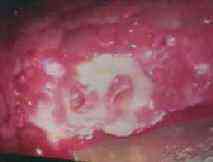
|
|
|
|
cochlea is drilled out.
|
4)
TRANS COCHLEAR APPROACH :
Like TO, the TC approach combines the TL with removal of the cochlea;
however wide access to the anterior CPA is provided by posterior
transposition of the facial nerve. Thus the exposure extends from
the sigmoid sinus posteriorly to the petrous carotidartery
anteriorly.
The
posterior transposition of the facial nerve results in an obligatory
temporary facial paralysis that produces some degree of aberrant
regeneration. The fifth,seventh, ninth, tenth, and eleventh cranial
nerves, the clivus, both the vertebral arteries and the basilar
artery are routinely seen.
One
added advantage of the approach is that during bony dissection to obtain
exposure, the blood supply and the tumor
base
are removed, which is particularly important in petrous ridge
meningiomas.
The
principle indications for this approach are large petro-clival
meningiomas, epidermoids, extensive gliomas, jugular
tumors
and even temporal bone malignancies.
Technique:
Surgical Highlights:
Retro auriculo temporal incision
Blind closure of external auditory canal
Subtotal petrosectomy
Posterior labyrinthectomy
Exposure of internal auditory canal
Decompression of mastoid, tympanic and labyrinthine segments of
facial nerve and geniculate ganglion
Division of greater superficial petrosal nerve and posterior
rerouting
Drilling out of anterior wall of IAC, cochlea,petrous tip and
clivus
Removal of tumor
Cavity obliterated with fat and temporalis muscle flap
Posterior transposition of the tympanic and vertical segments of the
facial nerve requires transection of the greater superficial petrosal
nerve. Following facial nerve transposition, cochlea and tympanic
ring removal exposes the carotid artery anteriorly, the jugular bulb and
inferior petrosal sinus inferiorly and the superior petrosal sinus
superiorly.
This approach provides direct access to the base of implantation and
blood supply of tumors arising from petrous tip and petroclival
junction. Temporary facial nerve paralysis occurs uniformly with
the posterior transposition of the facial nerve which is most likely the
consequence of devascularization of the perigeniculate segments of the
nerve caused by transection of the greater superficial petrosal nerve and
its accompanying vessels.
5) TRANSPETROUS APPROACH
In this procedure, full TC exposure is combined with infratemporal fossa
approach, orbitozygotomy and even transposition of petrous carotid artery.
This approach is indicated in only the most extreme extension of tumor
into the lateral cranial base and intracranially.
|